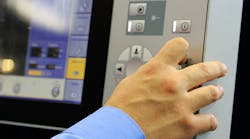Human-machine interface (HMI) software has come a long way in the last 30 years. Or has it? We are monitoring the same systems and need the same interface now as we did back then, I believe.
So where are the differences?
I tried to come up with a list of disparate items but came up short because the changes in HMI software that are coming may take some time to become embedded in standard HMI interfaces.
There is a trend to have the HMI integrated into the control hardware. Unitronics has merged its programmable logic controller (PLC) offering with its HMI software to create an all-in-one, one-size-fits-all controller.
Opto 22’s edge programmable industrial controller (EPIC) has Inductive Automation’s Ignition built-in, but you need a separate license for it, which is understandable. However, Opto’s standard HMI interface is available at no extra cost. The touch-screen interface also acts as a troubleshooting tool for the attached hardware, which is a very cool feature for edge-type controllers.
The newest Rockwell Control/CompactLogix has the capability for multiple operating systems. That means Windows could be mounted in one of the sessions that could run the HMI software, such as Factory Talk ME/SE. All that would be needed is a monitor and operator interface facilities, such as a touch screen and/or keyboard.
HMI software for machine control is localized to the controlled process, and because of that it needs to have the right array of objects and dynamic data to allow the operator (if there is one) to operate the process. This is where the lines between HMI and SCADA blur a bit.
Data historians are required to have historical trending, which can go back hours/days/weeks. Standard HMI trending will allow for a certain amount of history, but if the machine is a lights-out process, you may want to add a trending program/historian, such as Canary Labs, to the mix if you can.
Fixed HMIs run on their own operating systems so adding third-party software may not be an option, so it’s best to understand your needs before implementing the solution.
One component of HMI software that has started to garner some attention is the ability to process data at the edge. This requires that the HMI/controller combination should support additional protocols, such as MQTT. MQTT is a very lightweight network messaging protocol that allows for data to be sent between two locations. The reason for its popularity is that it can be used very effectively over low bandwidth network connections and over data-driven networks such as cellular. This can keep costs down.
Another trend in the HMI space is the need for the HMI to process data (like a SCADA system) as well as the ability to push this processed data to the cloud directly. This suggests that the HMI must be on the OT network, which infers Ethernet connectivity. This is very commonplace in today’s control strategy.
One of the newcomers on the HMI scene is ADISRA, from the founder of InduSoft. InduSoft was sold to Invensys back in 2013. ADISRA stands for Aware, Diverse, Integrated, Self-Regulated and Adaptive. It intends to be the answer to any of your HMI questions including Industry 4.0 and the Industrial Internet of Things (IIoT).
The ability to use MQTT allows ADISRA to connect processed data to the cloud directly. I would suggest that all newer HMI software will engage in this behavior as time moves on.
One trend that I cannot wrap my head around is accessing the main HMI screens using a mobile phone. Screen real estate is at such a premium with complex applications that the usefulness of a six-inch screen is questionable.
The other trend that I find hard to consider is remote access using your mobile device. Security is the issue here. Even a flashlight application can provide a problematic response with your device.
Also read: The transformation of HMIs
Enter Suppanel—an android application to create HMI supervisory panels. It can use Ethernet/IP, OPC, Modbus TCP or Siemens Step 7 protocols to communicate to a controlling device. Again security is a possible issue here, but to be fair I have not installed, used and reviewed the product, but I find that with a device that is dedicated to an HMI application I really don’t have any issues with it. With a personal device however with various apps and games installed, I think it is a case of user beware.
Having alarming being pushed to a mobile device can be very useful. Location services maybe useful as well since certain alarms could be pushed to the device(s) in the area instead of to all in the list.
Call me old fashioned but I need a big screen to have a basic overview of the process. The attraction of mobility however is a very valid posture.
We have an exciting HMI future ahead of us. Let us be ready!!





